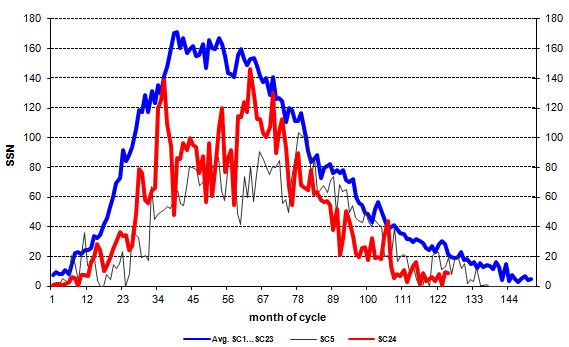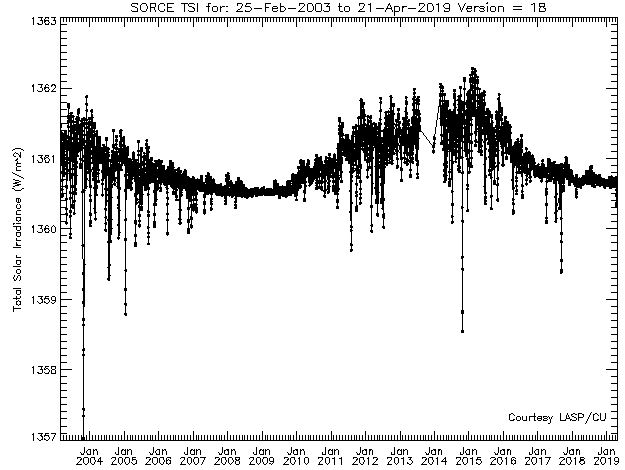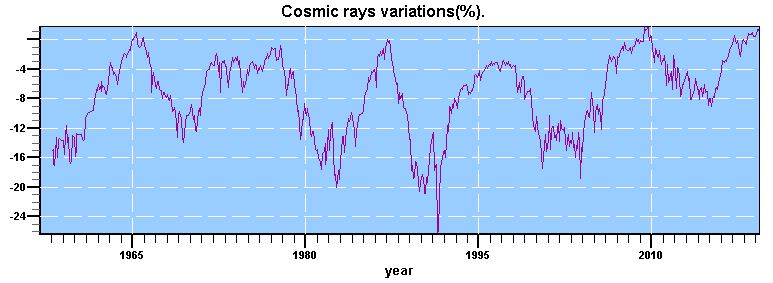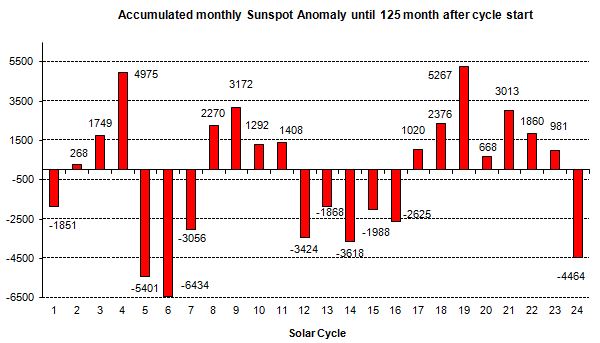The Sun in April 2019
By Prof. Fritz Vahrenholt and Frank Bosse
(German text translated/edited by P. Gosselin)
If we speak of an average of the last 23 cycles in the months of the minimum, our only significant energy source at the center of the solar system was below average active last month as well.
The sunspot number (SSN) was 9.1, which was thus only 42% of the average of the cycles for month no. 125. Some cycles (No. 21, 18, 16, 15, 8 ) were already completed in month no. 125.

Fig. 1: The monthly sunspot activity of the current solar cycle (SC 24) since December 2008 (red) compared to the mean value of all previously systematically observed cycles since the beginning of SC 1 in March 1755 (blue) and the very similar SC 5 (black).
Figure 1 clearly shows that the latest cycle was quite below-normal, especially at the beginning and after the second peak which had an SSN of over 140 towards the end. Since February 2014 (the maximum of the entire cycle 24 with SSN = 146 in cycle month 63), it only reached 2/3 of the average activity.
What are the effects? The total radiation (TSI for total solar irradiance) is only moderately influenced:

Fig. 2: The total solar irradiance at the Earth’s distance since the end of 2003, when probe’s mission began. Source.
Since the maximum, we have seen a decrease of about 1.5 W/m². On the ground this drop decreases to 25% because the earth is not perpendicular to the sun (like the satellite’s sensor) and it rotates. This leaves only a boost of 0.38W/m² in effective radiant power, or 0.1%, which is comparatively little.
Another magnitude may have more influence: During high activity, the sun keeps the galactic cosmic radiation (actually less electromagnetic radiation, but more particles) away from the interior of the solar system. It performs this shielding less effectively with reduced solar activity.

Fig. 3: Galactic radiation since the 1960s. The series has been measured in Moscow. Source. Note: Upper peaks show strong cosmic radiation.
Since the beginning of the 2000s, a decrease of up to 16% compared to the 90s can currently be seen. Also in the maximum of SC24 around 2014 cosmic rays were about 8% stronger than in the maxima since 1980.
We had reported about the connections, which Hendrik Svensmark postulates, in the book and also in the blog (last here) several times.
Next we look at the comparison of the cycles among each other:

Fig. 4: The sunspot activity of the cycles in comparison. The numbers in the diagram are obtained by summing the monthly differences between the observed SSN and the mean (blue in Fig.1) up to the current cycle month 125.
Also the coming cycle 25 – with a probable start in August 2020 (here we showed how we came to this view) – will again be below average with a high degree of certainty. The peak phase of solar activity from 1935 to about 2005 (SC 17…SC23) is over.





Earlier it was noted that the thermosphere had shrunk and this too has possible impacts on air mass movements lower down where the weather (and climate change) affects us.
From this observation the Thermosphere Climate Index (TCI) was produced. It can be seen here at https://spaceweatherarchive.com/2018/10/26/a-new-space-weather-metric/
The TCI is an attempt to link the high altitude variation (caused by solar variation) to what happens further down where the weather happens. Note where we are now — Solar minimum and the thermosphere is cooling off.
[…] Fonte: No Tricks Zone […]
Your headline says “potentially cloud seeding”. Is there any real world evidence of a change in global cloud cover linked to solar cycles?
Yes, there’s a lot of evidence, and was even confirmed by CERN experiments.
Also the coming cycle 25 – with a probable start in August 2020 (here we showed how we came to this view) – will again be below average with a high degree of certainty. The peak phase of solar activity from 1935 to about 2005 (SC 17…SC23) is over.
There is no link showing how you came to this conclusion.
There are some who say cycle 25 has already started eg http://milesmathis.com/updates.html “NEW PAPER, added 4/26/19, Solar Minimum Blues. The mainstream is still misdirecting on the start of Cycle 25, and I am here to expose them.” and “PAPER UPDATE, added 4/28/19, Solar Minimum Blues. A kind reader sent me a link to a Solar System generator, allowing me to fine-tune my predictions for the tail-out of Cycle 25 after 2025”
I can’t see any “papers” in your link.
I do wish all these graphs could by labeled by month/year so the data had some meaning to the reader. As here presented it has little meaning until we translate it from the rather obtuse language in which it is presented.
[…] Read more at No Tricks Zone […]
I agree with Adrian Vance. A summary of these observations/recordings in language more familiar to the non-scientific community would enable a larger universe of people to appreciate the impact of all of this.
Month 125, April 2019, means it’s the 5th month of year 11 in the 11-year solar cycle. I understand why they count months like that being solar scientists, but having a Carl Sagan translate it for us would help spread knowledge about the sun’s influence on our climate. I’ll be topping off the propane tank in October is for dang sure.
[…] https://notrickszone.com/2019/05/07/current-solar-cycle-among-weakest-on-record-potentially-cloud-se… […]
[…] https://notrickszone.com/2019/05/07/current-solar-cycle-among-weakest-on-record-potentially-cloud-se… […]
[…] https://notrickszone.com/2019/05/07/current-solar-cycle-among-weakest-on-record-potentially-cloud-se… […]
[…] recent cooling, as revealed in the studies mentioned earlier, coincides with the weakest solar cycle on record. The current solar cycle (number 24) is the weakest on record, and scientists have predicted that […]
[…] recent cooling, as revealed in the studies mentioned earlier, coincides with the weakest solar cycle on record. The current solar cycle (number 24) is the weakest on record, and scientists have predicted that […]
[…] new cooling, as printed within the research discussed previous, coincides with the weakest sun cycle on file. The present sun cycle (quantity 24) is the weakest on file, and scientists have predicted that the […]
[…] hot cooling, as published within the research discussed previous, coincides with the weakest sun cycle on report. The present sun cycle (quantity 24) is the weakest on report, and scientists have predicted that […]